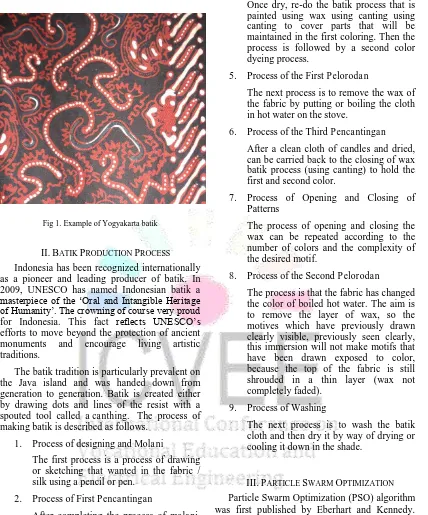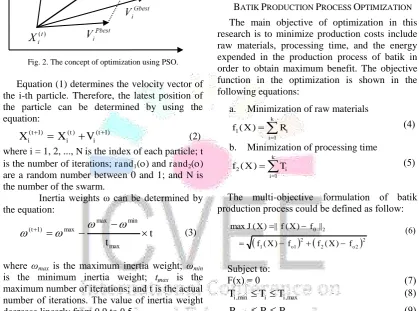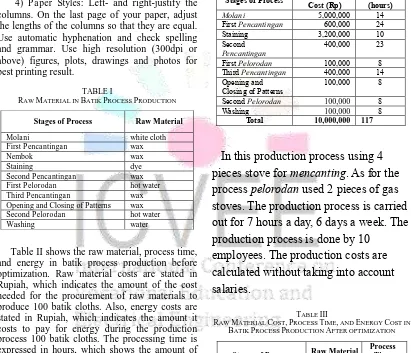Application of Particle Swarm Optimization
Method for Batik Production Process
Indah Soesanti
1, Adhi Susanto
2, Ramadoni Syahputra
31,2
Department of Electrical Engineering and Information Technology, Faculty of Engineering,
Universitas Gadjah Mada Yogyakarta, Indonesia
1
3Department of Electrical Engineering, Faculty of Engineering, Universitas Muhammadiyah Yogyakarta
Yogyakarta, Indonesia [email protected]
Abstract– The process steps of batik are designing, ‘pencantingan’, staining, ‗pelorodan’, and washing. These process steps determine production cost of batik industry. This paper presents application of particle swarm optimization (PSO) method for batik production process optimization. Production cost is determined by the efficiency and calculation of input to output ratio in the production process. In this research, PSO method is used to optimize the production process on Yogyakarta batik industry. The main objective of this research optimization is to minimize the cost incurred in the production process of batik in order to obtain maximum benefit. PSO method has successfully optimized the production goals to be achieved by minimization the using of raw materials and production time.
Index Terms - batik; production process; optimization; particle swarm optimization.
I. INTRODUCTION
One of the potential of small and medium industries at the local level were developed in an effort to accelerate economic empowerment is commodities eminent in the field of creative industries. In the future, the creative industries are into a leading industry in most of Yogyakarta province. One of the creative industries that are still the flagship is the batik industry [1]. This industry is one of the leading industries in Yogyakarta province, where the creative industries have developed into becoming an industry cluster. Batik industry is expected to give a significant role in supporting the industrial sector's contribution to the local revenue of Yogyakarta province.
In the industrial world, the comparison between the production cost and selling price can affect the competitiveness in the market. Production cost is determined by the efficiency and calculation of input to output ratio in the production process. Efficiency is a measure maximize results by using capital (labor, material and tools) are minimal. Efficiency can also be
interpreted as an effort to use the smallest input to obtain maximum production [2-3]. Thus, the management can combine the factors of production with certain management techniques so as to produce a product effectively and efficiently in the quantity, quality, and time of production.
Business potential batik industry in this province can be demonstrated by the availability of labor is quite large, the amount of demand for batik products are relatively stable, and the number of batik production are also relatively stable, although recent years slightly decreased due to the batik products imported from China. In addition, the batik production process optimization opportunities a distinct advantage for the progress and development of the batik industry, especially in Yogyakarta province. Fig 1 shows the example of Yogyakarta batik.
Fig 1. Example of Yogyakarta batik
II.BATIK PRODUCTION PROCESS Indonesia has been recognized internationally as a pioneer and leading producer of batik. In 2009, UNESCO has named Indonesian batik a masterpiece of the ‗Oral and Intangible Heritage of Humanity‘. The crowning of course very proud for Indonesia. This fact reflects UNESCO‘s efforts to move beyond the protection of ancient monuments and encourage living artistic traditions.
The batik tradition is particularly prevalent on the Java island and was handed down from generation to generation. Batik is created either by drawing dots and lines of the resist with a spouted tool called a canthing. The process of making batik is described as follows.
1. Process of designing and Molani
The first process is a process of drawing or sketching that wanted in the fabric / silk using a pencil or pen.
2. Process of First Pencantingan
After completing the process of molani, the second step is pencantingan namely painting fabric with wax using the canting by following a pattern that has been made on both sides of the fabric (back and forth).
3. Process of Staining
The process is the first coloring process on the part that is not covered by wax by dipping the cloth in a particular color. Once dipped, the fabric in the drying and dried.
4. Process of the Second Pencantingan
Once dry, re-do the batik process that is painted using wax using canting using canting to cover parts that will be maintained in the first coloring. Then the process is followed by a second color dyeing process.
5. Process of the First Pelorodan
The next process is to remove the wax of the fabric by putting or boiling the cloth in hot water on the stove.
6. Process of the Third Pencantingan After a clean cloth of candles and dried, can be carried back to the closing of wax batik process (using canting) to hold the first and second color.
7. Process of Opening and Closing of Patterns
The process of opening and closing the wax can be repeated according to the number of colors and the complexity of the desired motif.
8. Process of the Second Pelorodan
The process is that the fabric has changed the color of boiled hot water. The aim is to remove the layer of wax, so the motives which have previously drawn clearly visible, previously seen clearly, this immersion will not make motifs that have been drawn exposed to color, because the top of the fabric is still shrouded in a thin layer (wax not completely faded).
9. Process of Washing
The next process is to wash the batik cloth and then dry it by way of drying or cooling it down in the shade.
the distance from the global best position, as shown in the following equation:
) ( ) ( ) ( ) ( ) ( 2 2 ) ( 1 1 ) ( ) 1 ( t i i t i i t i t i X Gbest r and c X Pbest r and c V V (1)
Fig. 2. The concept of optimization using PSO.
Equation (1) determines the velocity vector of the i-th particle. Therefore, the latest position of the particle can be determined by using the equation: ) 1 ( ) ( ) 1
(
t i t i ti
X
V
X
(2)where i = 1, 2, ..., N is the index of each particle; t is the number of iterations; ra nd1() and rand2() are a random number between 0 and 1; and N is the number of the swarm.
Inertia weights ω can be determined by the equation:
t
t
t
max min max max ) 1 (
(3)where ωmax is the maximum inertia weight; ωmin is the minimum inertia weight; tmax is the maximum number of iterations; and t is the actual number of iterations. The value of inertia weight decrease linearly from 0.λ to 0.5.
The improved PSO algorithm is described as follows:
1. Input the data of the raw materials, processing time and the energy expended in the production process of batik and initialize the parameters of PSO.
2. Run the program of raw materials, processing time, and the energy expended in the production process of batik to measure the fitness (length) of each particle (pbest) and store it with the best value of fitness (gbest). 3. Update velocity of particle using (1). 4. Update position of particle using (2).
5. Decrease the inertia weight (ωΨ linearly from 0.9 to 0.4.
6. Perform violation of particle position: If particle position pos(j)>mp, then pos(j)=mp
Else if particle position pos(j)<mp, then pos(j)=1.
7. Perform violation of particle velocity: If particle velocity vel(j)>mv, then vel(j)=mv
Else if particle velocity vel(j)<-mv, then pos(j)= -mv.
8. Decrease the inertia weight (ωΨ linearly from 0.9 to 0.4.
Repeat steps 2-8 until a criterion is obtained. BATIK PRODUCTION PROCESS OPTIMIZATION The main objective of optimization in this research is to minimize production costs include raw materials, processing time, and the energy expended in the production process of batik in order to obtain maximum benefit. The objective function in the optimization is shown in the following equations:
a. Minimization of raw materials
k i i R X f 11( ) (4Ψ
b. Minimization of processing time
k i i T X f 12( ) (5Ψ
The multi-objective formulation of batik production process could be defined as followμ
22 2 2 1 1 2 0 ) ( ) ( || ) ( || ) ( max o
o f X f
f X f f X f X J
(6Ψ
Subject toμ
F(xΨ = 0 (7Ψ
max , min
, i i
i T T
T
(8Ψmax , min
, i i
i P P
P
(λΨwhere f1(XΨ is a cost function of raw materials;
f2(XΨ is a cost function of processing time; Ri is a raw variable of batik; Ti is a processing time variable; and Pi is an energy of batik processing.
Furthermore, based on cost functions as expressed in the equation (4Ψ to the equation (7Ψ conducted a multi-objective optimization to optimize the production process of batik in one of Yogyakarta batik industry.
IV.RESULTS AND DISCUSSION
A. Preparing Your Paper
1) Paper Size: Prepare your paper in full-size format on US letter size paper.
2) Type Sizes and Typefaces: Follow the font type sizes specified in Table I. The font type sizes are given in points, same as in the MS Word font size points. Times New Roman is the preferred font.
3) Paper Margins: Paper margins on A4 letter size paper are set as follows: top = 20 mm, bottom = 20 mm, left = 35 mm, and right = 20 mm.
4) Paper Styles: Left- and right-justify the columns. On the last page of your paper, adjust the lengths of the columns so that they are equal. Use automatic hyphenation and check spelling and grammar. Use high resolution (300dpi or above) figures, plots, drawings and photos for best printing result.
TABLE I
RAW MATERIAL IN BATIK PROCESS PRODUCTION
Stages of Process Raw Material
Molani white cloth
First Pencantingan wax
Nembok wax
Staining dye
Second Pencantingan wax
First Pelorodan hot water
Third Pencantingan wax
Opening and Closing of Patterns wax Second Pelorodan hot water
Washing water
Table II shows the raw material, process time, and energy in batik process production before optimization. Raw material costs are stated in Rupiah, which indicates the amount of the cost needed for the procurement of raw materials to produce 100 batik cloths. Also, energy costs are stated in Rupiah, which indicates the amount it costs to pay for energy during the production process 100 batik cloths. The processing time is expressed in hours, which shows the amount of time required for the production process 100 batik cloths.
Table II shows the raw material,
process time, and energy in batik process
production before optimization. Raw
material costs are stated in Rupiah, which
indicates the amount of the cost needed
for the procurement of raw materials to
produce 100 batik cloths. Also, energy
costs are stated in Rupiah, which
indicates the amount it costs to pay for
energy during the production process 100
batik cloths. The processing time is
expressed in hours, which shows the
amount of time required for the
production process 100 batik cloths.
TABLE II
RAW MATERIAL COST,PROCESS TIME, AND ENERGY COST IN BATIK PROCESS PRODUCTION BEFORE OPTIMIZATION
Stages of Process Raw Material Cost (Rp) Process Time(hours)
Molani 5,000,000 14
First Pencantingan 600,000 24
Staining 3,200,000 10
Second
Pencantingan 400,000 23
First Pelorodan 100,000 8 Third Pencantingan 400,000 14 Opening and
Closing of Patterns 100,000 8 Second Pelorodan 100,000 8
Washing 100,000 8
Total 10,000,000 117
In this production process using 4
pieces stove for
mencanting
. As for the
process
pelorodan
used 2 pieces of gas
stoves. The production process is carried
out for 7 hours a day, 6 days a week. The
production process is done by 10
employees. The production costs are
calculated without taking into account
salaries.
TABLE III
RAW MATERIAL COST,PROCESS TIME, AND ENERGY COST IN BATIK PROCESS PRODUCTION AFTER OPTIMIZATION
Stages of Process Raw Material Cost (Rp)
Process Time (hours)
Molani 4,500,000 12 First Pencantingan 500,000 21
Staining 2,900,000 9
Second Pencantingan 300,000 23
First Pelorodan 90,000 7
Third Pencantingan 300,000 12 Opening and Closing of
Patterns
90,000 7
Second Pelorodan 90,000 7
Washing 90,000 7
Total 8,860,000 105
Saving (%) 11.4 10.256
10,000,000 with as many as 117 hours of production time. Results of batik production process optimization using PSO method is shown in Table III. As shown in Table III that after the optimization of the production process of batik, the costs of raw materials needed is Rp 8,860,000 with as many as 105 hours of production time. Optimization results show that there is a saving of raw materials amounted to 11.4%. Results also showed an optimization of production time savings of 126 hours to 105 hours, or 10.256%. These savings would have an impact on improving operational efficiency in the batik industry. This optimization is expected to help strengthen the competitiveness of Yogyakarta batik industry.
V.CONCLUSION
This paper presents batik production process optimization using particle swarm optimization (PSO) method. Optimization results show that in batik production process, there is a saving of raw materials amounted to 11.4%. Results also showed an optimization of production time savings of 117 hours to 105 hours, or 10.256%. These savings would have an impact on improving operational efficiency in the batik industry. This optimization is expected to help strengthen the competitiveness of Yogyakarta batik industry.
ACKNOWLEDGMENT
The authors gratefully acknowledge the contributions of Ministry of Research, Technology and Higher Education, Republic of Indonesia, for funding this research.
REFERENCES
[1] I. Soesanti, ―Design of Batik Production Process Monitoring Based on Web Technology‖, Proceeding of National Seminar CITEE 2009, Electrical Engineering of UGM, Yogyakarta. 2009.
[2] S. Freihat, ―The Role of Marketing Information System in Marketing Decision-making in Jordanian
Shareholding Medicines Production Companies‖, IJRRAS, 11(2), May 2012.
[3] H. Afrisal, M. Faris, P. Utomo, I. Soesanti, F. Andri, ―Portable smart sorting and grading machine for fruits using computer vision‖, Proceeding - 2013 International Conference on Computer, Control, Informatics and Its Applications: "Recent Challenges in Computer, Control and Informatics", IC3INA 2013.
[4] R.N. Rohmah, A. Susanto, I. Soesanti, M. Tjokronagoro, ―Computer Aided Diagnosis for lung tuberculosis identification based on thoracic X-ray‖, Proceedings - 2013 International Conference on Information Technology and Electrical Engineering: "Intelligent and Green Technologies for Sustainable Development", ICITEE, Yogyakarta, 2013.
[5] R.N. Rohmah, A. Susanto, I. Soesanti, M. Tjokronagoro, ―Thoracic X-ray features extraction using thresholding-based ROI template and PCA-thresholding-based features selection for lung TB classification purposes‖, Proc. of 2013 3rd Int. Conf. on Instrumentation, Communications, Information Technol., and Biomedical Engineering: Science and Technol. for Improvement of Health, Safety, and Environ. ICICI-BME, 2013.
[6] H.A. Nugroho, N. Faisal, I. Soesanti, L. Choridah, ―Identification of malignant masses on digital mammogram images based on texture feature and correlation based feature selection‖, Proceedings - 2014 6th International Conference on Information Technology and Electrical Engineering: Leveraging Research and Technology Through University-Industry Collaboration, ICITEE, Yogyakarta, 2014.
[7] I. Soesanti, T.S. Widodo, ―Classification of Batik Pattern Based on Eigenimage Feature Extraction‖, Proceeding of National Seminar on Annual Engineering Seminar 2013, Engineering Faculty of UGM, Yogyakarta, Indonesia, 2013.
[8] I. Soesanti, A. Susanto, ―Image Compression Based on DCT and Adaptive Fuzzy Logics‖, Proceeding of National Seminar on Annual Engineering Seminar 2014, Engineering Faculty of UGM, Yogyakarta, Indonesia, 2014.
[9] R. Syahputra, I. Robandi, M. Ashari, ―Performance Improvement of Radial Distribution Network with Distributed Generation Integration Using Extended Particle Swarm Optimization Algorithm‖, International Review of Electrical Engineering (IREE), Vol. 10, No. 2, 2015, pp. 293-304.


